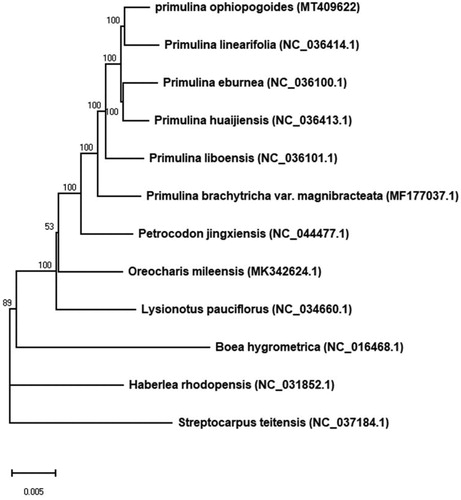Abstract
Primulina ophiopogoides is a perennial herb of Gesneriaceae distributed on the limestone rocks. Here, the complete chloroplast (cp) genome of P. ophiopogoides was assembled and characterized. The cp genome is in a total length of 152,718 bp with the typical quadripartite structure, containing 2 inverted repeats (IRs) of 25,472 bp separated by a large single-copy (LSC) region of 83,615 bp and a small single-copy (SSC) region of 18,159 bp. The whole cp genome of P. ophiopogoides contains 131 genes, including 86 protein-coding genes, 37 tRNAs genes, and 8 rRNAs. The phylogenetic analysis indicated that P. ophiopogoides displayed a closer kinship to Primulina linearifolia.
Primulina ophiopogoides (D. Fang & W. T. Wang) Yin Z. Wang is a perennial herb of Gesneriaceae. It is an endemic endangered species distributed on limestone rocks in Fusui and Longzhou County, Guangxi, China, usually growing on bare and unshaded rock crevices and showing very strong tolerance to extremely drought and high temperature in summer and autumn. The rhizome of P. ophiopogoides is a traditional Chinese medicine mainly used for rheumatism (Editorial Committee of the Flora of China Citation1990; Li and Wang Citation2004) and it is also an ornamental plant with fleshy leaves and purplish flowers. We report the complete chloroplast (cp) genome of P. ophiopogoides, which can be used to test the phylogenetic relationship to its congeners and provide basic data for future analysis of the adaptation mechanism to the harsh habitats.
Total DNA was extracted from the silica-dried leaves of P. ophiopogoides using a modified CTAB method (Doyle Citation1987), which were collected from Fusui county, Guangxi, China (22°39′41′′ N, 107°55′38′′ E). The voucher specimen (ZQ20180801) was deposited at IBK. The paired-end (PE150) sequencing was performed on NovaSeq 6000 system (in Novogene corp., Tianjin, China). Approximately 2.9 GB high-quanlity clean reads were obtained after filtering. Assembly and annotation were employed with SPAdes 3.11.0 (Bankevich et al. Citation2012) and PGA (Qu et al. Citation2019). The validated complete cp genome sequence of P. ophiopogoides was submitted to the GenBank (accession number: MT409622).
The cp genome of P. ophiopogoides is 152,718 bp in length with an average GC content of 37.6%, containing one large single-copy (LSC) region of 83,615 bp and one small single-copy (SSC) region of 18,159 bp, which are separated by two inverted repeat (IR) regions of 25,472 bp. A total of 131 unique genes are encoded for the cp genome, including 86 protein-coding genes, eight ribosomal RNA genes and 37 transfer RNA genes. Among them, 15 genes (i.e., trnK-UUU, rps16, trnG-UCC, atpF, rpoC1, trnL-UAA, trnV-UAC, petB, petD, rpl16, rpl2, ndhB, trnI-GAU, trnA-UGC, ndhA) contain one intron, while clpP and ycf3 harbor two introns, and rps12 has trans-splicing.
To investigate the phylogenetic relationships with the closely related species, the maximum likelihood (ML) phylogenetic tree was constructed by RAxML (Stamatakis Citation2006) based on 12 complete cp genomes in Gesneriaceae (). The tree shows P. ophiopogoides is a closer relative to Primulina linearifolia, which are supported by the similarity in morphological characters, such as narrow long leaves. The complete cp genome sequence of P. ophiopogoides can benefit further studies, such as on its adaptation mechanism.
Disclosure statement
No potential conflict of interest was reported by the author(s).
Data availability
The data that support the findings of this study have already uploaded to the NCBI (https://www.ncbi.nlm.nih.gov/) and get the reference number (MT409622). We have permitted the data can be released before the publication of the article, but until now the data has not been released in NCBI.
Additional information
Funding
References
- Bankevich A, Nurk S, Antipov D, Gurevich AA, Dvorkin M, Kulikov AS, Lesin VM, Nikolenko SI, Pham S, Prjibelski AD, et al. 2012. SPAdes: a new genome assembly algorithm and its applications to single-cell sequencing. J Comput Biol. 19(5):455–477.
- Doyle JJ. 1987. A rapid DNA isolation procedure for small quantities of fresh leaf tissue. Phytochem Bull. 19:11–15.
- Editorial Committee of the Flora of China. 1990. Flora of China. Volume 69. Beijing (China): Science Press; p. 392.
- Li ZY, Wang YZ. 2004. Plants in the family Gesneriaceae in China. Zhengzhou (China): Henan Science and Technology Press; p. 249.
- Qu XJ, Moore MJ, Li DZ, Yi TS. 2019. PGA: a software package for rapid, accurate, and flexible batch annotation of plastomes. Plant Meth. 15:50.
- Stamatakis A. 2006. RAxML-VI-HPC: maximum likelihood-based phylogenetic analyses with thousands of taxa and mixed models. Bioinformatics. 22(21):2688–2690.

